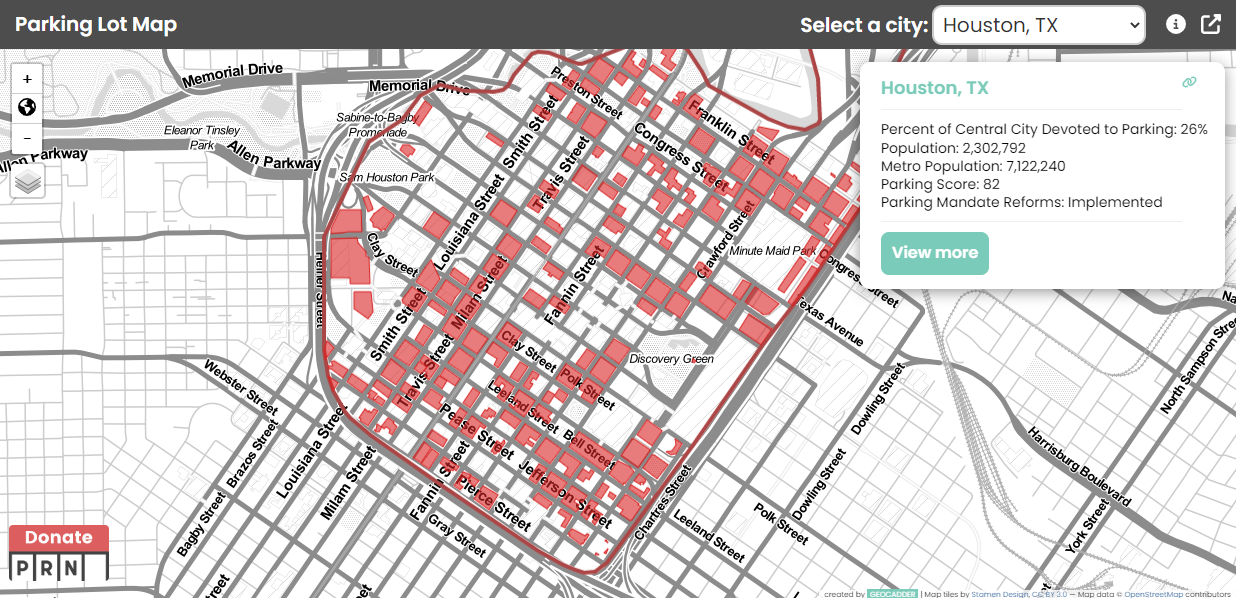I don’t know the answer to that, but this is how much we have.
Downtown Houston dedicates more than a quarter of its land to parking spaces, surpassing the percentages in most major U.S. cities, a new report shows.
A photo from the 1970s that went viral last year showed Houston’s downtown nearly engulfed by parking lots at the time. While less extreme today, 26 percent of the city center still serves as parking spaces, ranking Houston seventh in parking density among 50 major American metropolitan areas analyzed by the Portland-based Parking Reform Network.
Houston isn’t alone in Texas when it comes to high parking concentration, the report shows. San Antonio, Dallas, and Fort Worth closely followed the Bayou City in ninth, 11th and 12th place, respectively. Topping the list is Arlington, which sees a staggering 42 percent of its land occupied by parking lots and garages.
In contrast, New York City, Washington D.C., San Francisco, and Boston dedicate only 1 percent, 3 percent, 4 percent and 6 percent of their downtown areas to parking, respectively.
A car-centric downtown often leads to a less pedestrian-friendly environment, according to the network, whose research shows that an increase in central city parking typically results in a significant decrease in walkability.
“With all this parking, little land was left for anything else, making housing more expensive, less dense, and farther apart,” the report read. “It’s clear that if we want to have walkable cities, we need cities that are less parkable.”
As more than half of Houstonians consistently express their desire for a more walkable urban design in surveys, the city has taken steps towards this goal in recent years. These initiatives include expanding Houston’s network of sidewalks, implementing pedestrian-friendly rules for new developments in select neighborhoods and permanently closing down traffic on parts of Main Street.
In 2019, Houston also eliminated minimum parking requirements in parts of the Midtown and Downtown East neighborhoods — an exemption that already existed in the central business district — in order to prevent an excessive number of parking lots from consuming too much urban core space.
Meanwhile, some parking lots in Houston have started to vanish in the past decade. Between 2010 and 2022, 21 lots were demolished and replaced with buildings, Axios reported. These new developments include Discovery Green, Kinder High School for the Performing and Visual Arts, Partnership Tower, Marriott Marquis, Hampton Inn and Suites and Aris Market Square.
I generated the Houston downtown parking map here and embedded it above. Some of the parking indicated is multi-level, which isn’t great from a pedestrian-experience perspective, but at least takes up less surface area. I’m not sure what more can be done to squeeze in more actual buildings, with useful things in them, but at least we’ve taken some steps to increase what’s available. Ginger noted this tool in the April 7 Dispatches from Dallas; I couldn’t resist adding on when I saw the Chron story.


I have one acronym for you…HIWI
@Fredrick…. Hilsfreiwillage ?
Re: “In contrast, New York City, Washington D.C., San Francisco, and Boston dedicate only 1 percent, 3 percent, 4 percent and 6 percent of their downtown areas to parking, respectively.”
…maybe because everyone of those City sites has an extensive network of ‘heavy’ train, light rail, bus, commuter lines, Amtrack, subway systems, etc., that the Houston SMSA just can’t handle from a geographical (high water table), extensive urban sprawl, and/or elected representative perspective.
Those cities have geographical restrictions that forced more density and more vertical construction.
The parking lots in Houston will disappear as the need for more buildings occurs. There’s no point in building stuff that no one will use.
Pingback: Dispatches from Dallas, April 28 edition – Off the Kuff